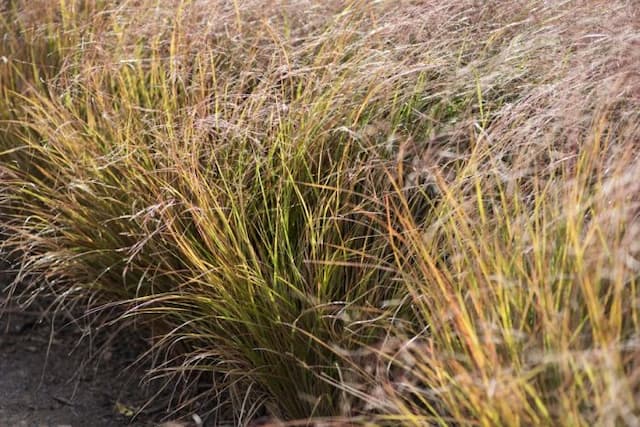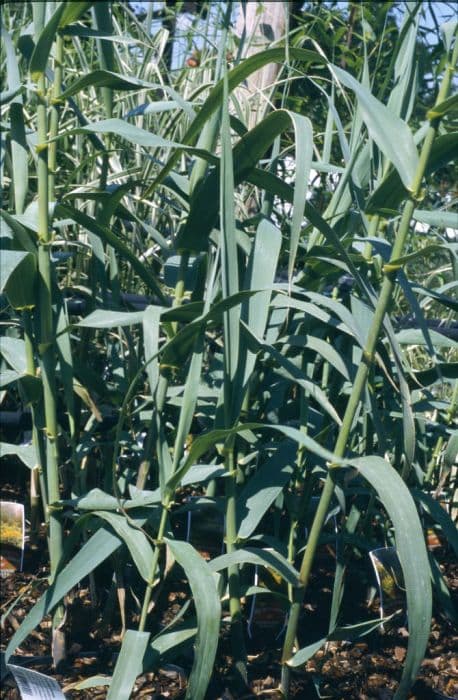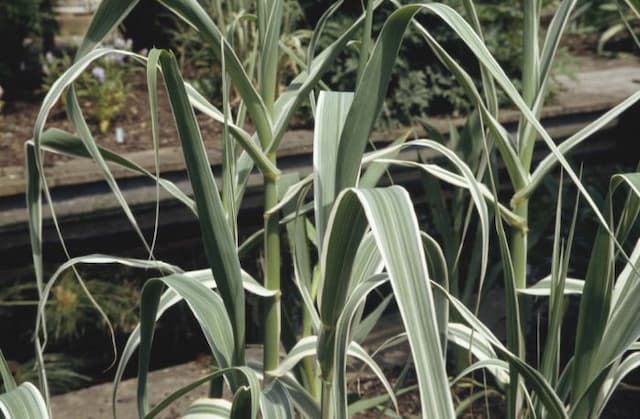Eulalia 'Kleine Fontäne' Miscanthus sinensis 'Kleine Fontäne'











ABOUT
'Kleine Fontäne' is a compact and free-flowering deciduous grass to 1.5m tall, the narrow arching leaves with white midribs, and turning yellow in autumn; feathery arching red flower heads open in late summer, soon turning silver
About this plant
 Names
NamesFamily
Poaceae
Synonyms
Chinese Silver Grass, Maiden Grass, Eulalia, Japanese Silver Grass, Porcupine Grass, Zebra Grass
Common names
Miscanthus sinensis 'Kleine Fontäne'.
 Characteristics
CharacteristicsLife cycle
Perennials
Foliage type
Deciduous
Color of leaves
Green
Flower color
Pink
Height
4-5 feet (1.2-1.5 meters)
Spread
2-3 feet (0.6-0.9 meters)
Plant type
Grass
Hardiness zones
5
Native area
Asia
Benefits
 General Benefits
General Benefits- Drought Resistance: Once established, it is able to withstand periods of limited rainfall.
- Low Maintenance: Requires minimal care when it comes to fertilizing, pest control, and watering.
- Erosion Control: Its root system helps stabilize soil and prevent erosion.
- Winter Interest: The plant's foliage and seed heads add aesthetic appeal to the landscape during colder months.
- Wildlife Habitat: Provides shelter and food for birds and small animals.
- Architectural Element: Adds structure and height to garden designs with its tall, upright growth habit.
- Adaptability: Tolerant of a variety of soil types, including poor soils.
- Privacy Screen: Can be used as a natural privacy barrier when planted in groups.
- Seasonal Color: Offers changing colors throughout the seasons, from green to bronze to silver.
- Non-Invasive: Unlike many other Miscanthus species, 'Kleine Fontäne' is less likely to spread uncontrollably.
 Medical Properties
Medical PropertiesThis plant is not used for medical purposes.
 Air-purifying Qualities
Air-purifying QualitiesThis plant is not specifically known for air purifying qualities.
 Other Uses
Other Uses- Miscanthus sinensis 'Kleine Fontäne', commonly known as Dwarf Fountain Grass, can be processed into biofuel due to its high biomass yield.
- Its sturdy stems can be used in the production of paper as an alternative to traditional wood fibers.
- The dried foliage is sometimes used in basket weaving or as a natural stuffing material for handcrafted dolls or pillows.
- The plant's fibers are used in some regions for making biodegradable pots for seedlings, reducing the use of plastics in gardening.
- Dwarf Fountain Grass can be utilized as erosion control in landscapes prone to soil degradation, thanks to its robust root system.
- When compacted, the dried plant material can serve as an environmentally friendly packing material for shipping fragile goods.
- It can be used in crafting natural brooms or brushes due to its fibrous and sturdy nature.
- The grass clippings from Dwarf Fountain Grass are an excellent addition to compost heaps, contributing to a nutrient-rich compost.
- The plant is sometimes incorporated into acoustic panels for sound dampening because of its thick, dense growth.
- In ornamental fish ponds, the dense root systems of this plant help to stabilize the banks and provide habitat for aquatic wildlife.
Interesting Facts
 Feng Shui
Feng ShuiThe Maiden Grass is not used in Feng Shui practice.
 Zodiac Sign Compitability
Zodiac Sign CompitabilityThe Maiden Grass is not used in astrology practice.
 Plant Symbolism
Plant Symbolism- Growth and Adaptability: Miscanthus sinensis 'Kleine Fontäne', commonly known as Chinese Silver Grass, is a hardy perennial that adapts to a variety of soil conditions and climates, symbolizing the ability of an individual to grow and prosper in various environments.
- Resilience: As a plant that can thrive in tough conditions and regrow after being cut back, Chinese Silver Grass showcases resilience and the notion of bouncing back from challenges or setbacks.
- Privacy: With its dense growth habit, Chinese Silver Grass is often used as a natural screen or barrier, representing the value of privacy and creating personal space.
- Elegance and Simplicity: The fine foliage and feathery flower plumes of Chinese Silver Grass give it an elegant appearance, symbolizing beauty in simplicity and understated grace.
- Time and Change: As a perennial that changes with the seasons, Chinese Silver Grass reflects the passage of time and the natural cycle of change, growth, and dormancy.
 Water
WaterMaiden Grass should be watered thoroughly once a week, allowing the soil to dry out slightly between waterings. During the peak growth season in spring and summer, the plant may require more frequent watering, especially in hotter climates or during dry spells. Provide approximately one inch of water each time, which is roughly equivalent to 0.6 gallons for a small plant or increased accordingly for larger plants. In the winter months, reduce watering frequency since the plant is not actively growing and excess water can lead to root rot.
 Light
LightMaiden Grass thrives in full sun, requiring at least six hours of direct sunlight each day for optimal growth. The best spot for this grass is an area where it is exposed to uninterrupted sunlight throughout the day. While it can tolerate some partial shade, too much shade can cause the grass to grow less vigorously and diminish its fall coloration.
 Temperature
TemperatureMaiden Grass prefers temperate conditions and is hardy in USDA zones 5 through 9. The ideal temperature range for this grass is between 50°F and 90°F. However, it can tolerate colder spells down to -20°F and can survive short periods of heat above 90°F. It is important for the plant to experience cooler temperatures in the fall and winter to properly enter dormancy.
 Pruning
PruningPrune Maiden Grass during late winter or early spring before new growth begins. This is done to encourage healthy new shoots and maintain an attractive shape. Cut back the grass to about 4 to 6 inches above ground level once a year. Pruning also helps to manage the size of the grass and removes any dead or damaged foliage from the previous growing season.
 Cleaning
CleaningAs needed
 Soil
SoilChinese silver grass thrives in a well-draining soil mix with loamy to sandy soil composition, and prefers a soil pH ranging from 5.5 to 7.5.
 Repotting
RepottingChinese silver grass is a large perennial grass and is not commonly repotted; division every few years in spring can rejuvenate the plant.
 Humidity & Misting
Humidity & MistingChinese silver grass is tolerant of a wide range of humidity levels and does not require any specific humidity conditions for optimal growth.
 Suitable locations
Suitable locationsIndoor
Provide bright light, ample space, and good air circulation.
Outdoor
Full sun, well-draining soil, water when dry, hardy plant.
Hardiness zone
4-9 USDA
 Life cycle
Life cycleMiscanthus sinensis 'Kleine Fontäne', commonly known as Maiden Grass, begins its life cycle as a seed, which, upon germination in spring, develops into a small seedling. The plant exhibits rapid vegetative growth through the warmer months, producing tall, narrow leaves and forming dense clumps. By late summer or early autumn, Maiden Grass produces feathery, tassel-like inflorescences that emerge pinkish or silver, adding ornamental value. After setting seed in the fall, the foliage typically fades to a beige hue and the plant enters dormancy during the winter months, with the above-ground biomass often persisting as visual interest in the landscape. In early spring, the dry, old growth is cut back to allow for new shoots to emerge from the plant’s underground rhizomes, completing the cycle and beginning a new growth period. Throughout its life, Maiden Grass expands through rhizome proliferation, gradually increasing the size of the clump.
 Propogation
PropogationPropogation time
Late summer to early fall
The most popular method of propagation for Miscanthus sinensis 'Kleine Fontäne', commonly known as the Chinese Silver Grass or Maiden Grass, is through division. This is typically done in the spring as new growth begins. To propagate, carefully dig up the entire plant, ensuring to get as much of the root system as possible. Then using a sharp spade or knife, divide the grass into smaller sections, each with a portion of the roots. Replant these divisions immediately, ensuring they are spaced appropriately to allow for their full size at maturity. Water the new plants thoroughly after planting to help establish them. Over time, these divisions will grow into full-sized plants, identical to the original Maiden Grass.









